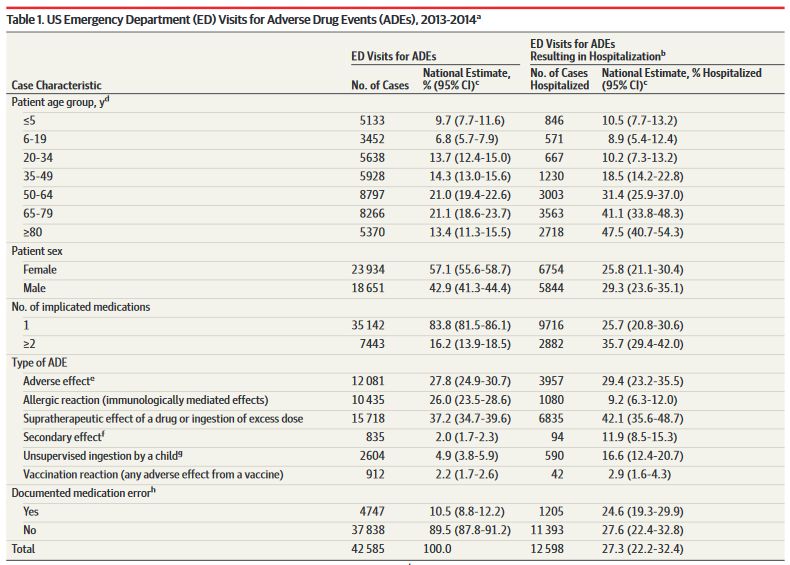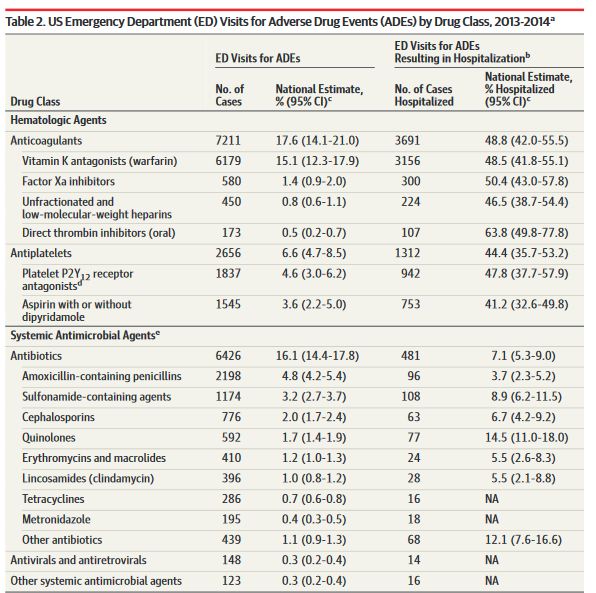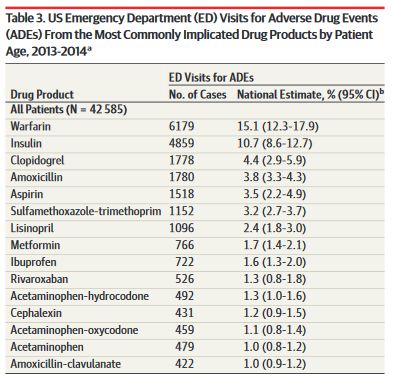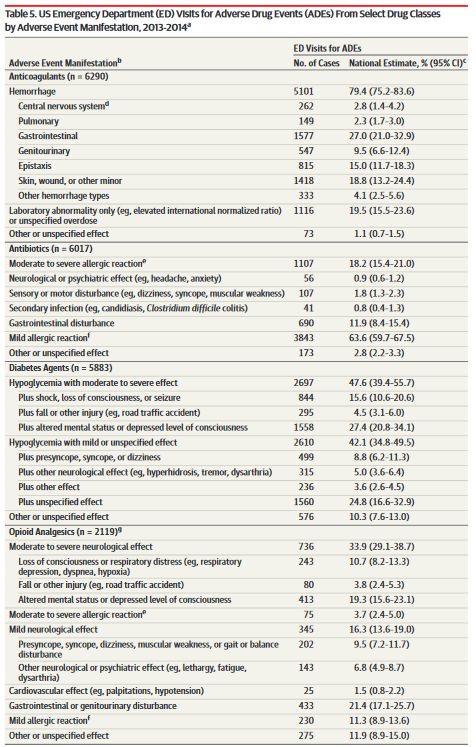No drug is free of risks, or the potential for causing harm. Every decision to take a drug needs to consider expected benefits and known risks. One of the ways we can reduce harms is by studying drug use rigorously. Only by understanding the “real world” effects of drugs can we understand the true risks (and benefits) and design strategies to reduce the risk of iatrogenic harm — that is, harms caused by the intervention itself. Adverse events related to drug treatments are common. Some lead to hospitalization. Studies suggest 28% of events are avoidable in the community setting, and 42% are avoidable in long-term care settings. That’s a tremendous amount of possible harm from something prescribed to help. A new study published this week shows that adverse drug events (ADEs) continue to cause significant problems, sending over a million Americans to the emergency room every year.
Understanding adverse events
An “adverse event” is an undesirable outcome related to the provision of healthcare. It may be a natural consequence of the underlying illness, or it could be related to a treatment provided. The use of the term “event” is deliberate, as it does not imply a cause: it is simply associated with an intervention. The term “adverse reaction,” or more specifically “adverse drug reaction,” is used where a causal relationship is strongly suspected. Not all adverse events can be causally linked to health interventions. Consequently, many adverse events associated with drug treatments can only be considered “suspected” adverse drug reactions until more information emerges to suggest the relationship is likely to be true. In many cases, such as with adverse drug events, the relationship is more obvious. Anticoagulants like warfarin (Coumadin) affects the ability of the blood to clot, and are used to reduce that risk. Doses must be customized and adjusted to keep the effect in the desired range: Too little, and the blood may still clot, causing heart attacks and strokes. Too much, and unwanted bleeding can occur. And warfarin’s effectiveness can be changed not only by other drugs, but by your diet. It’s a drug that can cause harm, but is also very effective.
Sometimes the best medicine may be no “medicine” at all. Fellow bloggers like David Gorski and Mark Crislip have written about the Choosing Wisely campaign, which aims to reduce unnecessary, wasteful and potentially harmful medicine. But a decision not to use a medication can have its own harms, like the case with warfarin. Ultimately, treatment decisions are personalized: we must consider individual patient characteristics and preferences in assessing benefits and risks. In a world with perfect prescribing and drug use, harms wouldn’t be eliminated, but they would be minimized.
This new analysis of ADEs is from Nadine Shehab and colleagues from the CDC. Entitled “US Emergency Department Visits for Outpatient Adverse Drug Events, 2013-2014,” it sought to understand patterns of ADEs that led to emergency department (ED) visits. Data was extracted from the National Electronic Injury Surveillance System – Cooperative Adverse Drug Event Surveillance (NEISS-CADES). 58 hospitals participated in the survey. At each site, data abstractors review the records of every ED visit and look for clinician-diagnosed ADEs. ADEs causing hospital admission were noted. Relevant drug- and patient-related data were extracted and then subsequently coded by CDC investigators. There are a lot of qualifiers that need to be understood before we look at the findings:
- Abstractors included prescription & over-the-counter drugs, dietary supplements, homeopathic remedies, and vaccines.
- ADEs included adverse effects, allergic reactions, effects from excess doses, secondary effects (choking or injection reactions), accidental ingestions (e.g. poisonings), and vaccine reactions.
- This was an analysis of ADEs transcribed by abstractors, so the ADE had to have been identified in the clinical record. Any ADE not identified would therefore not be included.
- Events EXCLUDED included withdrawal effects, drug failures, occupational exposures, intentional self-harm (e.g., overdoses), and recreational drug use or abuse.
- Emergency departments in integrated systems like the VA or Kaiser Permanente were not eligible for inclusion.
The key takeaway I had from this list is that the results will be a dramatic underestimate of ADEs. Not only did the ADE have to be severe enough to lead to an ED visit, the ADE had to be identified in the ED. Having said that, the accompanying editorial notes that excluding integrated systems like the VA means that systems that may be more effective at preventing ADEs were omitted.
The results
Based on the abstracted data, ADEs were tabulated and numbers were extrapolated to estimate the total number of potential ADEs in the United States.
42,585 ED visits were examined. An estimated 4 ED visits per 1,000 individuals occurred annually. This results in a national estimate of 1.3 million ED visits per year, suggesting a 10% increase over 2005/06. Perhaps not surprisingly, 34.5% of these adverse events are occurring in those over the age of 65. In this group, there’s an estimated 9.7 ED visits per 1,000 individuals. And remarkably, over 27% of ADEs that are identified in the ED lead to a hospital admission. Table 1 shows the breakdown by age and type of ADE:

Note how the likelihood of an ADE leading to a hospital admission approaches 50% with increasing age. The authors have compared their findings with 2005/06 data and concluded that the number of ADEs in older adults has increased from 26.5% to 34.5%.
It’s also interesting to note that it’s a single drug, rather than a drug-drug interaction, that led to the majority of ADEs presenting in the ED. The risk of ADEs goes up dramatically with more drugs taken simultaneously, so this finding surprises me. The most common finding was actually an excessive (supratherapeutic) dose. Importantly, medication errors were documented in 10% of ED visits for ADEs. These are warning flags that prescribing quality is poor. And this isn’t just the fault of prescribers, pharmacists aren’t catching errors, either.
Let’s now look at the drugs causing ADEs. Not surprisingly, the anticoagulants like warfarin top the list. Antibiotics came in second, followed by diabetes drugs. These top three categories were associated with almost 50% of the ADEs documented. I won’t show the entire table as it covers two pages, but here’s the top drugs:

And while many consumers believe that dietary supplements don’t cause adverse events, herbals and vitamins were associated with more ADEs that some widely used categories of drugs, like gastrointestinal products, and approached the ADE frequency of drugs like the nonsteroidal antinflammatory products:

The drugs implicated in the ADE reports varied by age, and below I’ve excerpted the overall results. Not surprisingly, anticoagulants lead. And in children under the age of 5 (not shown here), it’s also not surprising to antibiotics are associated with the most ADEs. More alarming is the fact that antipsychotics are the second-most commonly associated drug class with ADEs in children and teens aged 6-19.

Finally, I will show the entire table 5 which details the types of harms that are being identified in the ED. Bleeding was observed in almost 80% of ADEs involving an anticoagulant. Moderate to severe allergic reactions were observed in 18% of antibiotic-associated ADEs. Hypoglycemia with moderate to severe neurological effects in almost 50% of ADEs associated with drugs to treat diabetes. Finally, moderate to severe neurological effects in a third of those reporting an ADE associated with an opioid medication:

More needs to be done
One approach that I’ve written about before is called deprescribing or more crudely “drugectomies”, which involves discontinuing drug therapies if the expected clinical benefits are small. The approach involves an examination of every prescribed drug and confirming that it’s still medically appropriate and necessary, while considering patient preferences and overall quality of life. Anything with unclear benefit is jettisoned. And patients can sometimes feel much better as a result with a simplified medication schedule and the possible elimination of any drug-induced adverse effects. An even better approach is not starting drug therapy at all, when the benefits are expected to be minimal. Antibiotics continue to be overused for respiratory infections that are often due to viruses, not bacteria. And this data shows that antibiotics are sending more people to the emergency room than you might suspect.
Reducing the incidence of ADEs is not something that will respond to “quick fixes”. It requires health professions to reassess the prescribing and use of medications. It also requires continued scrutiny of “real world” use of drugs to ensure that the overall toxicity risk can be understood. Crucially, I think more effective collaboration is necessary between physicians and pharmacists who must work together to manage and monitor medication use. Adverse drug events can’t be eliminated, but this study gives more evidence to suggest that far too many people are hospitalized as a result of their drug therapy each year.
Image from flickr user KOMUnews used under a CC licence.
